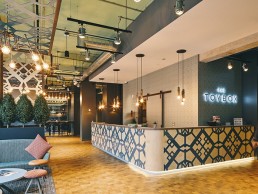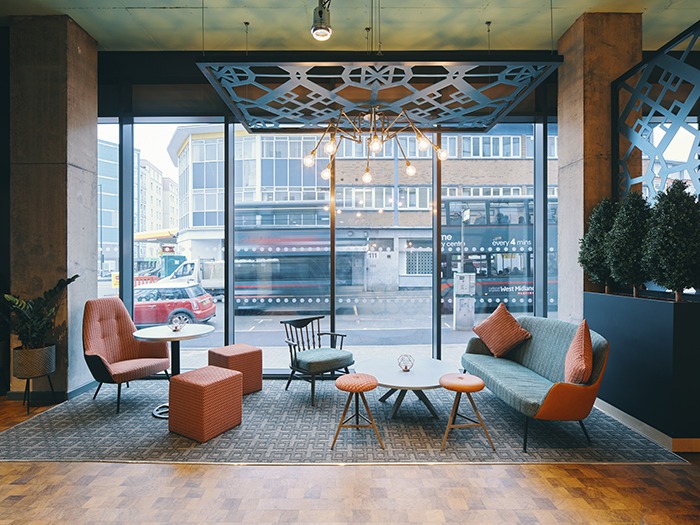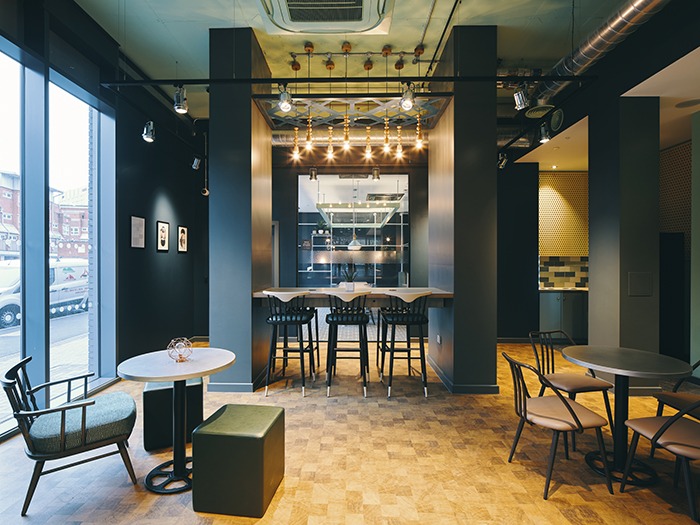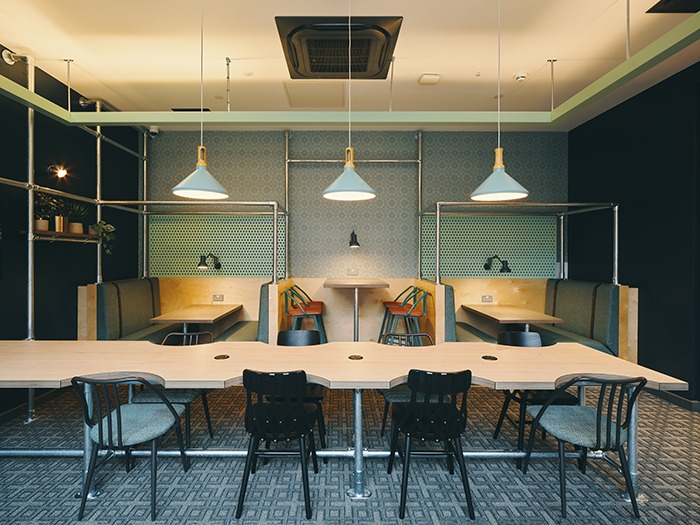
The Toybox, UK
The Toybox is the latest student accommodation to hit Birmingham. Architects 74 drew from the city’s rich history in metalwork in order to form the interior’s narrative.
The Toybox is a new-build 15-storey student accommodation block from architects Corstorphine + Wright. A glazed, green brick and zinc-clad block in the Westside area of Birmingham, UK, the interior design – from Manchester-based architects and interior designers 74 – is comprised of 290 student apartments. 74 was commissioned to create the dynamic series of communal spaces that make up the ground floor area, including a reception, lounge, study area, gaming area, kitchenette, staff welfare space, toilets and fitness suite.
Toybox is inspired by the location’s history and industrial past, including the metalworking and gold-and-silver smithing workshops. The term ‘toy’ was used in the 18th Century to describe the industry in the English Midlands and could refer to anything from hinges and buttons, to belt buckles and hooks – it wasn’t until years later that the term ‘toy’ changed to its modern form and definition.
“We drew on the concept of raw, industrial workshops and contrasted that with the decorative and ornate items that would have been produced there,” says 74 Associate Bianca Yousef. “This manifested as exposed ceilings and wall treatments, plus tarnished metals and metal tubing, along with laser-cut and geometric patterns, dramatic feature lighting, button references and spindle detailing on the timber furniture.”
Students enter the building beneath a cantilevered external canopy through two sets of double sliding doors, with an immediate vista revealed down a central circulation corridor with lounge seating to the left and co-working and fixed seating areas at the rear. To the right of the entrance is the reception, which wraps around the central inner wall to be visible to those going straight to the lift lobby on the right and up to their rooms.

For the design of the reception space, 74 worked with Newmor to develop a bespoke fretwork-style wallpaper pattern to sit behind a dramatic six-metre-long desk. The pattern is then repeated throughout the scheme, for example the desk-front is laser-cut using the same pattern in blue-grey against a timber background with a grey laminate desktop and a pale blue laminaye base, lit along its entire length.
Four clusters of three pendant lights above – the E2 three-light brass tube pendant cluster in brushed antique brass – introduce subtle spindle shapes into the scheme for the first time. Fixed just above head height, these small clusters create an intimate and welcoming feel to reception.
Directly above the lounge seating – suspended through bespoke geometric fretwork rafts – three San Mateo contemporary chandeliers from Mullan Lighting create an eye-catching window display, while further architectural track lighting adds additional light above reception to highlight the wallpaper rear wall and again to light the central walkway. “As the eight-arm chandeliers feature exposed lamps, geometric pattern shadows are also cast on the pale mint-green ceiling from the rafts and Benjamin floor lamps by Frandsen are used to create a homely feel,” adds Yousef.
In the fixed seating area, a raised six-person desk is situated at the end of the corridor space at a right angle, semi-enclosed between dark-grey-painted structural columns. Feature lighting here is a series of eight Eglo Avoltri oak wooden spindle drop pendants, continuing the turned-timber theme.
Beyond the fixed seating area is the study lounge – this is a quieter, carpeted and more decorative area, featuring a variety of set-ups for study. Included in this space is a timber and steel-tubing window table and a row of banquette booths and tables, lit by Anglepoise wall lights, which give a nod to workshop lamps and the area’s heritage. Metal steel tubing is used to form a decorative structure above the booths, which continues along the main wall to the rear of the room, allowing for mirrors, clocks and artwork to be displayed. Ball wall lights from Frandsen in petroleum blue are also used to form part of the steel tubing wall, while also featuring in the tea-point area and games lounge.

Pendant lighting in the fixed seating areas comes in the form of a series of Coral pendants in an aqua finish by New Zealand-based David Trubridge and mint-green pendants from E2 Lighting – continuing the subtle colour palette that is taken through the scheme. Wrapping back towards reception is a lift lobby with dark walls and timber-effect flooring. Pendant lights over the entire corridor section are Anglepoise Giant pendants.
Commenting on the lighting scheme at Toybox, which was supplied by Enigma Lighting, Yousef tells darc: “The contrast of the ornate feature lighting against the more industrial architectural lighting fixtures helped reinforce the narrative of the scheme. The track lighting and spots were also used to draw attention to specific elements and key features of the space – for example, in the reception and lobby, spotlights are angled towards the ‘mailbox’ signage, highlighting the metallic detailing of the wayfinding, as well as creating reflections on the adjacent wall – evoking imagery of the glistening ‘jewelbox’.
“The lighting is fundamental to the overall concept of the design as it brings both industrial and decorative features to each space. The materiality and colours of the fittings all relate back to the key finishes used in the design, creating a continuity that runs through the scheme. Pockets of light also create a hospitality feel that brings a softness and warmth to the entire project. All the light fittings chosen add a contemporary twist to the original historical references that were used as inspiration.
“The initial client brief and narrative for the scheme were extremely strong and didn’t waiver,” continues Yousef. “This allowed the scheme to evolve naturally, while layers were added at each design stage, resulting in a coherent and rich design that utilises every detail to tie the concept and compelling story together. While there were not structural constraints, it was important that we use elements of the building to influence the placement and heights of the light fittings.

“For example, the external glazing transoms dictated the height of the rafts to create a more intimate lounge area opposite the reception – this allowed the large feature chandeliers to sit below the rafts and be seen fully from the outside. The pendants over reception were then set to a much lower height so they could also be seen externally, creating a playful and exciting view into the space.
“The powerful and evocative theme we were given from the outset was very beneficial and became a key driver for the whole design. Having this brief early on helped the entire design team to produce a clear narrative that can be seen from the architecture, to the branding and through to the interior design, resulting in a holistic design with a rich story and identity.”



